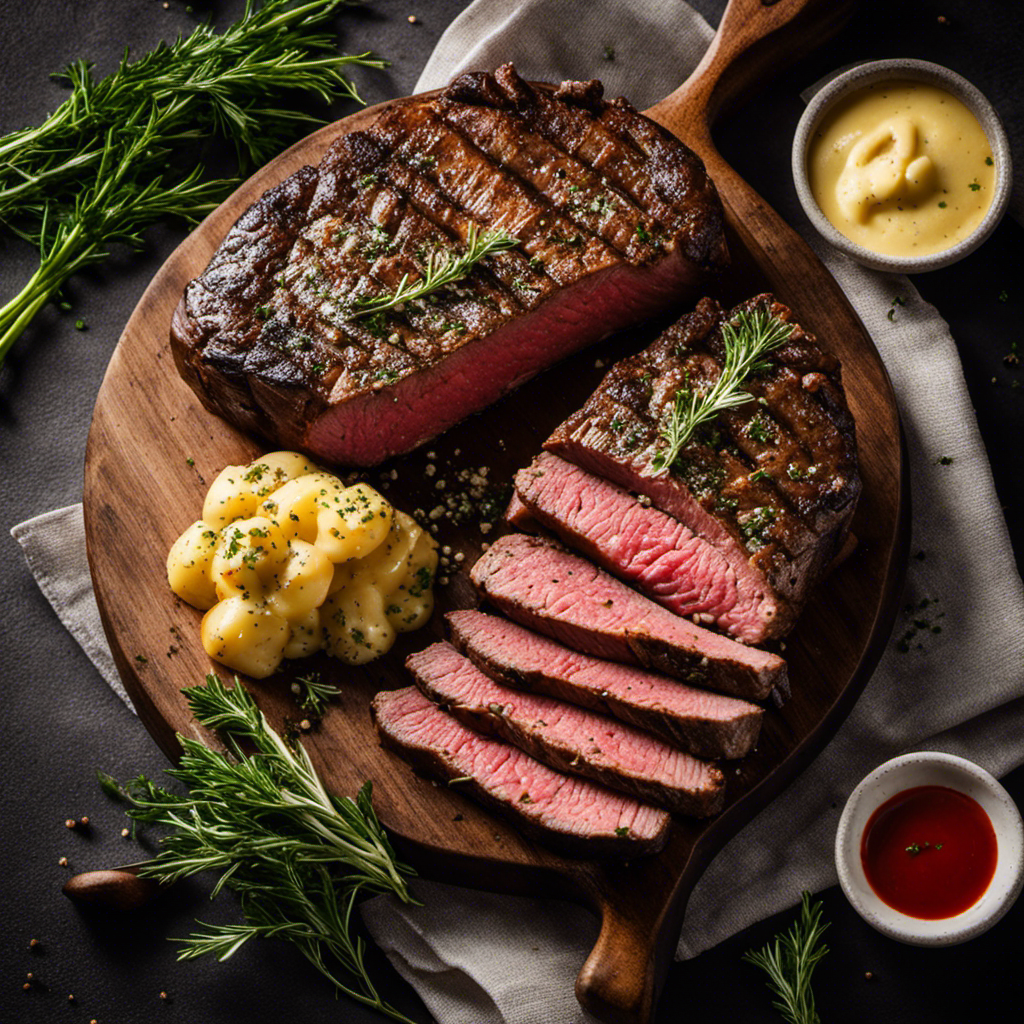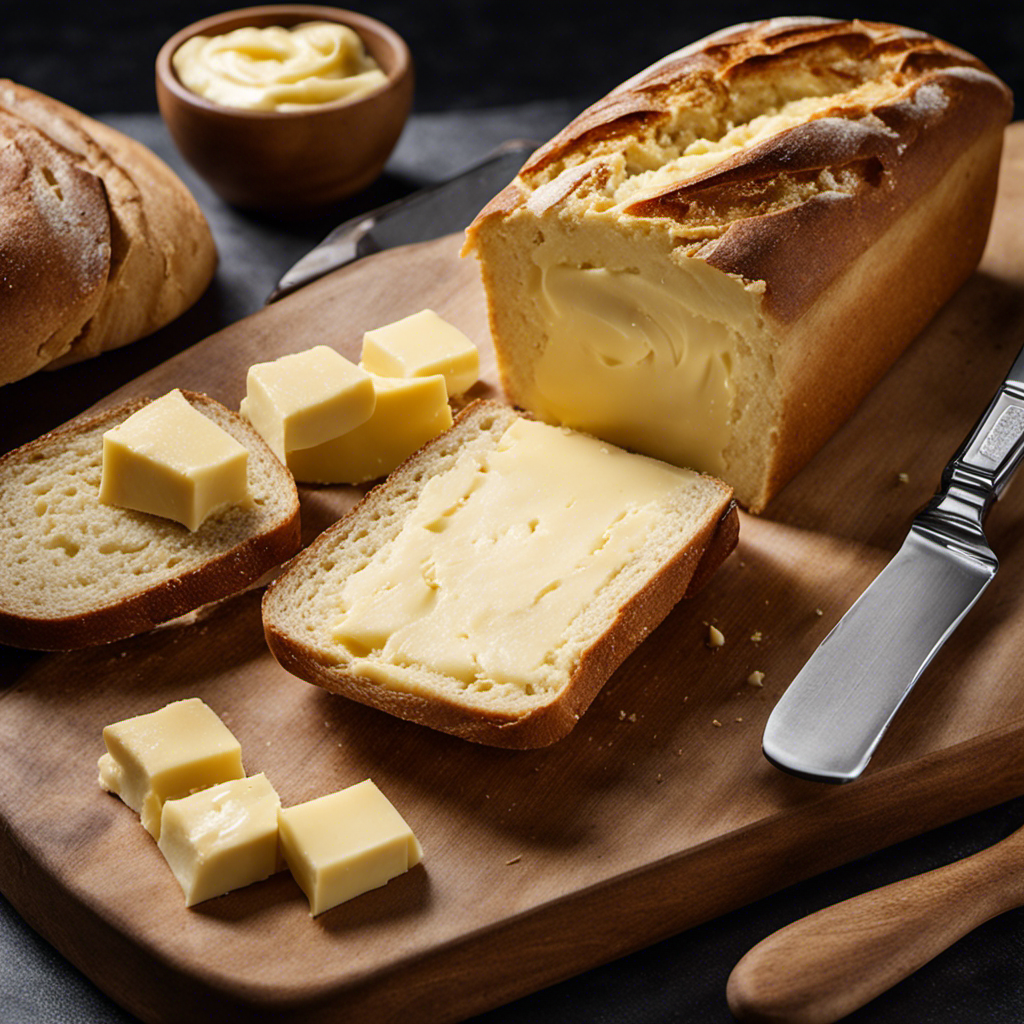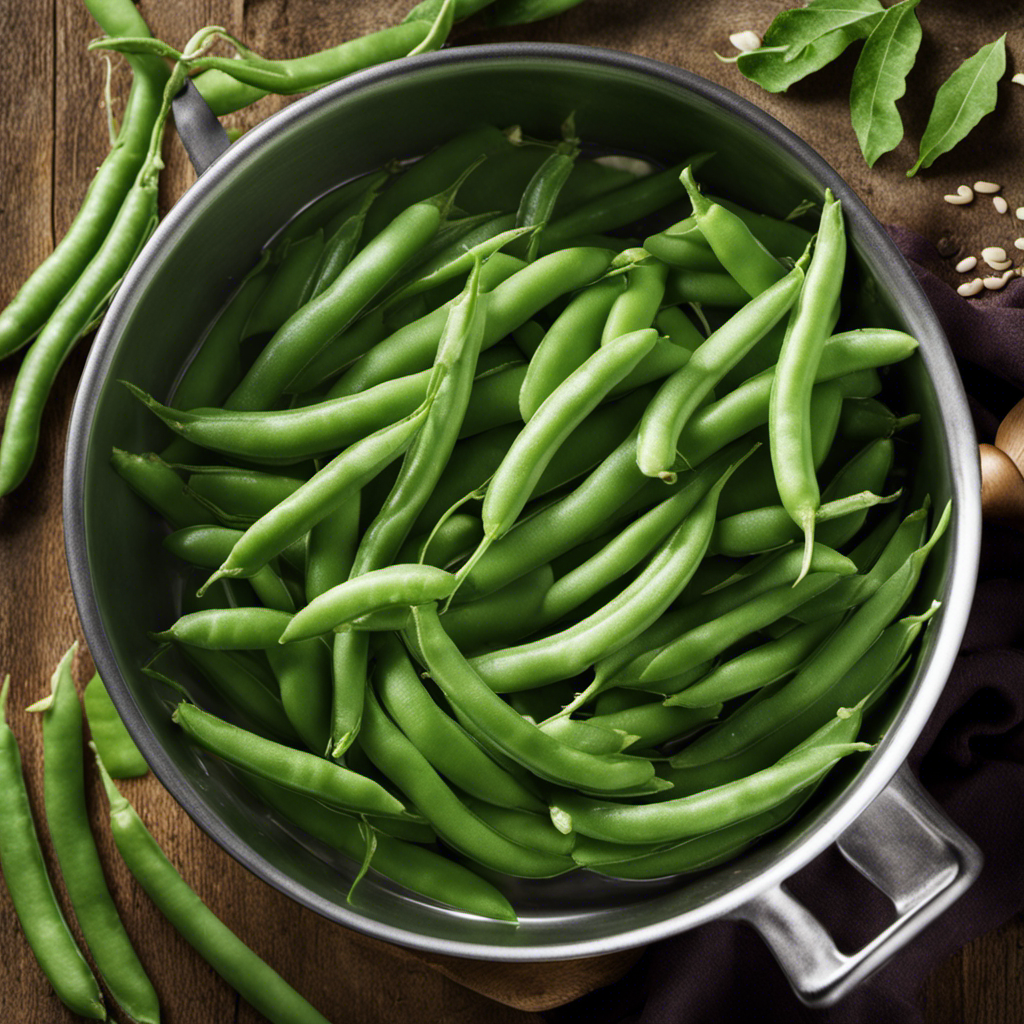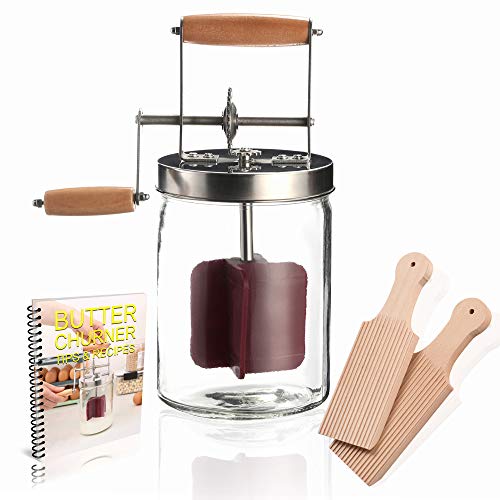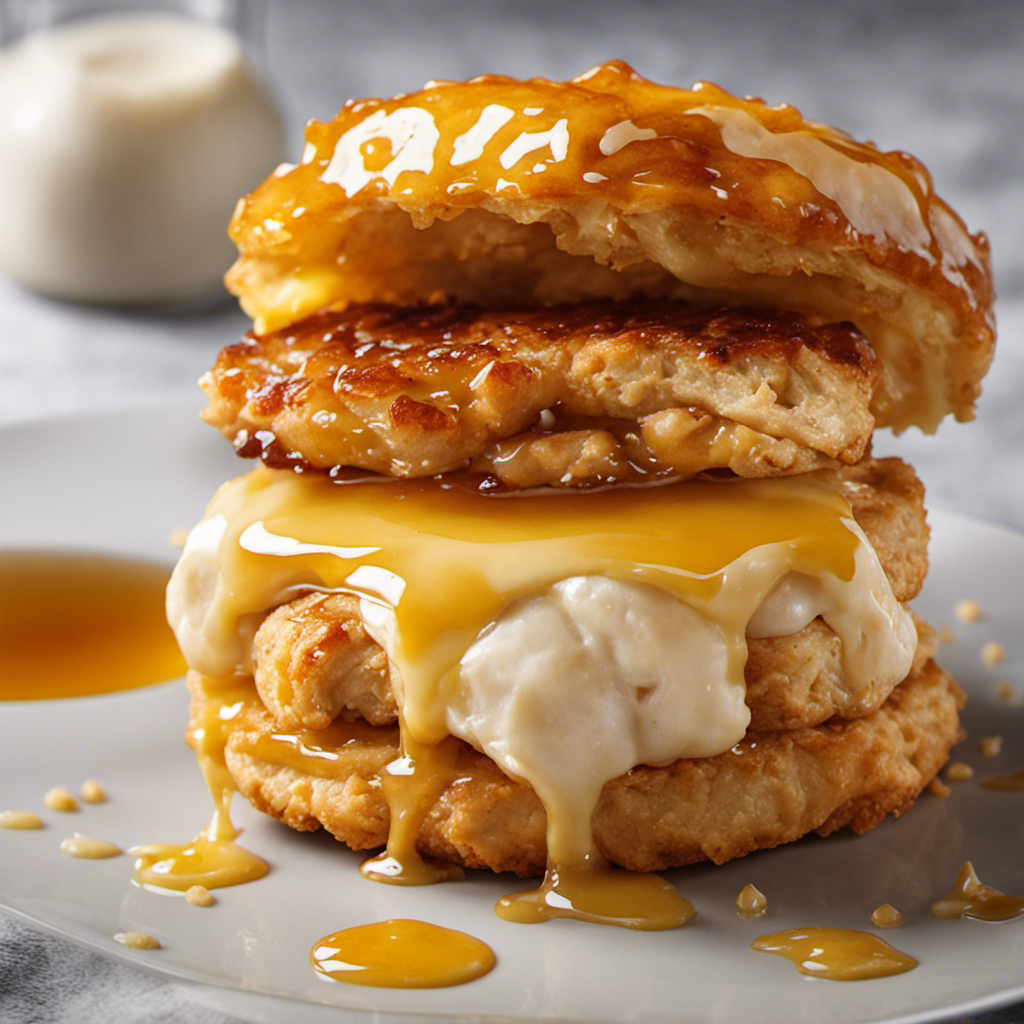I have uncovered a delicious secret for elevating a perfectly cooked steak to new heights: steak butter.
This heavenly concoction will elevate your steak game to new heights, adding a burst of rich, savory flavor with every bite.
With just a few simple steps, I’ll show you how to create this indulgent masterpiece that will make your taste buds sing.
Trust me, once you try this delectable steak butter, there’s no going back.
Key Takeaways
- Select a high-quality cut of meat for the best steak butter.
- Fresh ingredients are crucial for a rich and flavorful steak butter.
- Experiment with alternative ingredients to enhance flavor profiles.
- Applying the butter to the cooked steak creates a luscious coating.
Choosing the Right Cut of Steak
To make the best steak butter, you’ll want to start by choosing the right cut of steak. The key to a delicious steak butter lies in selecting a high-quality piece of meat.
My personal favorite cut for steak butter is the ribeye. Its marbling and rich flavor make it perfect for this indulgent dish.
When it comes to cooking methods, I highly recommend grilling or pan-searing the steak. These techniques allow for a beautiful caramelization on the outside while keeping the inside juicy and tender.
As for marinating techniques, I believe a simple blend of garlic, herbs, and a touch of soy sauce is all you need. Let the flavors infuse for at least an hour before cooking, and you’ll be rewarded with a steak butter that is bursting with flavor.
Gathering the Necessary Ingredients
When it comes to making the perfect steak butter, the ingredients you choose are crucial. Fresh ingredients are of utmost importance if you want to achieve a rich and flavorful butter that will elevate your steak to new heights.
While there are some alternative ingredient options out there, nothing beats the taste and quality of using fresh ingredients.
Ingredients for Steak Butter
The ingredients you’ll need for steak butter are butter, garlic, parsley, salt, and pepper. Let me tell you, this steak butter is not just for slathering on top of your perfectly cooked steak. Oh no, it has so many alternative uses that will make you wonder why you haven’t been using it sooner. Trust me, once you try it, you’ll be adding it to everything.
Here are four ways you can use this delicious steak butter to elevate your meals:
- Spread it on toasted bread for a mouthwatering garlic bread experience.
- Melt it on top of grilled vegetables to add a savory richness.
- Toss it with hot pasta for a quick and flavorful sauce.
- Use it as a base for sautéing mushrooms or shrimp for an extra burst of flavor.
Not only does this steak butter enhance the taste of your dishes, but it also offers some health benefits. Garlic, for example, is known for its immune-boosting properties, while parsley is packed with vitamins and antioxidants. So go ahead, indulge in this creamy, flavorful butter and reap the rewards of its alternative uses and health benefits.
Importance of Fresh Ingredients
Using fresh ingredients is key to creating flavorful and nutritious dishes that will leave your taste buds wanting more. When it comes to making steak butter, the quality of the ingredients can make all the difference. Fresh herbs, spices, and other flavorings can elevate the taste of your butter and complement the richness of the steak. By using freshly sourced ingredients, you ensure that the flavors are vibrant and the nutrients are at their peak.
To emphasize the importance of fresh ingredients, let’s explore different flavors for steak butter in a table:
| Flavor | Description | Emotional Response |
|---|---|---|
| Garlic and Herb | A classic combination that adds depth | Comfort and satisfaction |
| Smoky Chipotle | Adds a hint of spice and smokiness | Excitement and adventure |
| Zesty Citrus | Brightens the butter with a tangy kick | Refreshment and invigoration |
| Spicy Jalapeno | Adds heat and a punch of flavor | Boldness and intensity |
| Sweet and Savory | Combines sweetness and umami for balance | Indulgence and satisfaction |
Exploring these flavors with fresh ingredients will take your steak butter to the next level, providing a culinary experience that is both exciting and delicious.
Alternative Ingredient Options
To elevate your flavor profile, consider trying alternative ingredient options in your steak butter recipe. I’m a firm believer that experimenting with different flavors and textures can take a dish from good to exceptional.
When it comes to steak butter, there are a variety of butter substitutes that can not only enhance the taste but also provide numerous health benefits. Here are four alternative ingredient options that I highly recommend trying:
-
Avocado Oil: This heart-healthy oil adds a creamy and buttery texture to your steak butter while providing essential nutrients like vitamin E and healthy fats.
-
Ghee: Made from clarified butter, ghee has a rich and nutty flavor that pairs perfectly with steak. It is also lactose-free and contains healthy fats that promote brain function.
-
Coconut Oil: This tropical oil adds a subtle sweetness to your steak butter and has numerous health benefits, including boosting metabolism and supporting heart health.
-
Cashew Butter: Creamy and delicious, cashew butter adds a subtle nutty flavor to your steak butter. It is also a great source of protein and healthy fats.
Preparing the Steak for Butter Infusion
When it comes to achieving the perfect steak, the choice of cut is crucial. In my opinion, the best steak cuts for butter infusion are ribeye and filet mignon.
Both cuts have a tenderness and marbling that allows the butter to melt into the meat, enhancing its flavor and juiciness.
As for the butter infusion technique, I find that a compound butter made with herbs and garlic works wonders, adding a rich and aromatic touch to the steak.
Best Steak Cuts
For the best steak cuts, you can’t go wrong with a juicy ribeye or a tender filet mignon. These cuts offer the perfect balance of flavor and tenderness, making them the top choices for steak lovers. Here are four reasons why these cuts are the best:
-
Ribeye: This cut comes from the rib section of the cow, known for its marbling and rich flavor. It’s perfect for grilling, as the fat melts and enhances the taste.
-
Filet Mignon: This cut is the epitome of tenderness, with a buttery texture that melts in your mouth. It’s best pan-seared to seal in the juices and create a flavorful crust.
-
Best Steak Marinades: Whether you choose a ribeye or filet mignon, marinating your steak can take it to the next level. A combination of soy sauce, Worcestershire sauce, garlic, and herbs can enhance the flavors and tenderize the meat.
-
Grilling vs. Pan Searing Steaks: Grilling gives steaks a smoky flavor and beautiful grill marks, while pan-searing creates a delicious crust. Both methods are great, so choose based on your preference.
Now that we’ve covered the best steak cuts, let’s dive into the world of butter infusion techniques.
Butter Infusion Techniques?
Try experimenting with different herbs and spices to infuse your butter with unique flavors that will elevate your dishes to a whole new level. Butter infusion techniques are a fantastic way to enhance the taste of your meals and add a burst of flavor.
One of my favorite flavor pairing suggestions is garlic and parsley. The pungent garlic combined with the freshness of parsley creates a delightful and versatile butter that can be used on a variety of dishes.
Another fantastic combination is lemon and dill. The citrusy tang of the lemon pairs perfectly with the herbal notes of dill, creating a refreshing and zesty butter that is perfect for seafood or grilled vegetables.
Don’t be afraid to get creative and try different combinations. The possibilities are endless, and your taste buds will thank you.
Seasoning the Steak
First, you’ll want to generously rub the steak with a blend of your favorite seasonings. This step is crucial to ensure that your steak is packed with flavor from the inside out. Here are the best seasoning techniques that I’ve found to elevate the taste of any steak:
- Salt and Pepper: A classic combination that enhances the natural flavors of the meat.
- Garlic and Herb Blend: The aromatic garlic and herbs add a delicious depth to the steak.
- Smoky Spice Rub: Perfect for those who enjoy a smoky and slightly spicy flavor profile.
- Citrus Marinade: Marinating the steak in a citrus-based marinade not only adds tanginess but also helps to tenderize the meat.
By marinating the steak with these seasonings, you’ll create a mouthwatering taste that will have your guests coming back for seconds.
Now, let’s move on to making the steak butter compound.
Making the Steak Butter Compound
When it comes to seasoning a steak, I believe that finding the best steak seasoning is crucial for enhancing the flavor and taking it to the next level. From my experience, a combination of coarse salt, black pepper, garlic powder, and paprika creates the perfect blend of flavors that perfectly complement the natural taste of the beef.
However, if you’re looking to switch things up or prefer a healthier option, there are also some fantastic butter alternatives that can be used to add richness and moisture to your steak without compromising on taste.
Best Steak Seasoning
For the best steak seasoning, you can’t go wrong with a blend of salt, pepper, garlic powder, and paprika. This combination of flavors adds depth and enhances the natural taste of the meat. Trust me, I’ve tried countless seasonings, and this one always comes out on top. Here’s why:
- Salt: It brings out the natural juices of the steak, making it tender and juicy.
- Pepper: Adds a subtle kick and enhances the overall flavor profile.
- Garlic powder: Infuses the steak with a rich, savory taste.
- Paprika: Gives the steak a beautiful color and a hint of smokiness.
Now, when it comes to cooking methods, I must admit, I’m a grilling enthusiast. There’s just something about the charred exterior and smoky flavor that can’t be beaten. However, pan-searing can also produce a delicious steak, with a caramelized crust and juicy interior. It all comes down to personal preference and the equipment you have available.
Butter Alternatives for Steak?
To add a creamy richness to your steak without using butter, consider trying out alternative spreads like avocado or olive oil-based options.
Not only do these butter alternatives bring a delightful taste to your grilled masterpiece, but they also offer a range of health benefits. Avocado, for example, is packed with heart-healthy monounsaturated fats and essential nutrients like potassium and vitamin E.
Olive oil, on the other hand, contains antioxidants that can help reduce inflammation and improve cholesterol levels. By choosing these alternatives, you can enhance the flavor of your steak while keeping an eye on your health.
Now, let’s move on to the next step: infusing the butter with flavors.
Infusing the Butter With Flavors
You can start infusing the butter with flavors by combining softened butter, minced garlic, and chopped herbs in a bowl. This is where the magic happens and you can get creative with your flavor combinations. Here are four infusing techniques that will take your steak butter to the next level:
-
Citrus Zest: Add a burst of freshness by grating the zest of a lemon or lime into the butter mixture. This will give your steak a bright and tangy flavor.
-
Spices and Herbs: Experiment with different spices and herbs like rosemary, thyme, or smoked paprika. These ingredients will add depth and complexity to your butter.
-
Cheese Blend: Mix in grated Parmesan or blue cheese for a rich and savory butter that will melt beautifully on your steak.
-
Heat it up: For those who like a little kick, add some minced jalapenos or a dash of hot sauce to turn up the heat on your steak.
Now that your butter is infused with delicious flavors, let’s move on to the next step of applying it to the steak.
Applying the Butter to the Steak
Once the flavors have been infused into your butter, it’s time to generously spread it onto your perfectly cooked steak. The moment the hot meat touches the velvety smoothness of the butter, it begins to melt, creating a luscious coating that enhances every bite.
As the butter melts, it seeps into the crevices of the steak, infusing it with a rich, savory flavor. The melted butter also adds a touch of indulgence, giving the steak a luxurious mouthfeel that elevates the entire dining experience.
The butter acts as a natural basting agent, ensuring that every morsel is moist and succulent. The combination of the steak’s juices and the melted butter creates a delectable sauce that begs to be savored.
With the butter applied, the stage is set for the next step: cooking the steak to perfection.
Cooking the Steak to Perfection
Cook the steak until it reaches the desired level of doneness and let it rest before slicing. Cooking a steak to perfection requires attention to detail and a good understanding of cooking temperatures. Here are four essential tips for cooking the perfect steak:
-
Preheat your grill or pan to a high heat. This will ensure a nice sear on the outside of the steak while keeping the inside tender and juicy.
-
Use a meat thermometer to check the internal temperature of the steak. For medium-rare, aim for 135°F (57°C), while medium should be around 145°F (63°C).
-
Consider marinating the steak before cooking to enhance its flavor and tenderness. Experiment with different marinades, such as a simple mixture of olive oil, garlic, and herbs.
-
Let the steak rest for a few minutes after cooking. This allows the juices to redistribute within the meat, resulting in a more flavorful and tender steak.
Resting the Steak
After cooking the steak to perfection, the next crucial step in achieving a truly succulent and flavorful piece of meat is to allow it to rest. Resting the steak is a vital process that should not be overlooked. During this time, the juices redistribute and the internal temperature continues to rise slightly, resulting in a more tender and juicy steak.
Resting time is just as important as the cooking process itself. I usually let my steak rest for about 5-10 minutes, tented loosely with foil to keep it warm. This allows the meat to relax and ensures a more even distribution of the juices when you finally cut into it.
Temperature control is also key during this resting period. You want to make sure the steak stays warm, but not too hot. The foil tent helps to maintain the ideal temperature, preventing the steak from cooling down too quickly.
Slicing and Serving the Steak
To slice and serve the steak, simply use a sharp knife and cut against the grain for maximum tenderness and flavor. This technique ensures that each bite of steak melts in your mouth, releasing its rich juices and savory goodness.
Now, let me share with you my top serving techniques and garnishing ideas to elevate your steak to the next level:
-
Plating: Place the sliced steak on a warm plate to retain its temperature and serve as the centerpiece of the dish.
-
Sauce Drizzle: Add a drizzle of homemade steak butter on top of the sliced steak to enhance its flavor and create a luscious, velvety texture.
-
Herb Sprinkle: Sprinkle some freshly chopped herbs, such as parsley or thyme, over the steak slices to add a pop of freshness and aroma.
-
Garnish with Color: Finish off the presentation by garnishing the plate with vibrant, colorful vegetables or a sprinkle of microgreens for a visually appealing touch.
With these serving techniques and garnishing ideas, you’ll turn a simple steak into a masterpiece.
Now, let’s move on to the next section and explore how to store and reuse the steak butter compound.
Storing and Reusing the Steak Butter Compound
When storing the steak butter compound, it’s important to keep it in an airtight container to maintain its freshness and flavor. I have found that using a glass jar with a tight-fitting lid works best for preserving the rich taste of the butter. The key is to keep it away from air and moisture, which can cause it to spoil. I also recommend storing it in the refrigerator to extend its shelf life.
To help you understand the process of storing and reusing the steak butter compound, I have created a table below:
| Storage Method | Pros | Cons |
|---|---|---|
| Airtight jar | Maintains freshness and flavor | May occupy more space in the refrigerator |
| Plastic container | Lightweight and easy to handle | May affect the taste of the butter |
| Wax paper wrapping | Convenient for individual portions | Can be messy and prone to tearing |
Frequently Asked Questions
How Long Should I Let the Steak Rest Before Slicing and Serving?
I always let my steak rest for at least 5 minutes before slicing and serving. This resting time allows the juices to redistribute, resulting in a more flavorful and tender steak. It’s an essential step in steak preparation.
Can I Use Any Type of Butter for Making the Steak Butter Compound?
I love experimenting with different types of butter when making the steak butter compound. It adds a unique flavor and richness to the dish. You can even try alternative ingredients like ghee or compound butter for a delicious twist.
How Long Should I Cook the Steak for It to Be Considered "Cooked to Perfection"?
To achieve the perfect level of doneness, I rely on a cooking time of 5 minutes per side for a medium-rare steak. This allows for a juicy, tender center while still achieving a flavorful sear on the outside.
Can I Use the Same Compound Butter for Multiple Steaks?
Yes, you can definitely use the same compound butter for multiple steaks! It’s a versatile and delicious addition that adds flavor and richness to any meat. Plus, you can also use leftover compound butter for other dishes like roasted vegetables or grilled seafood.
Can I Store the Steak Butter Compound in the Freezer for Long-Term Use?
Yes, you can definitely store the steak butter compound in the freezer for long-term use. It’s one of the best and most convenient options for preserving the flavors and ensuring your butter stays fresh for a longer period of time.
Conclusion
In conclusion, making steak butter is a delicious and indulgent way to elevate your steak game. By choosing the right cut of steak and infusing it with a homemade compound butter, you can create a mouthwatering meal that will impress your guests.
Some may argue that making steak butter is time-consuming and unnecessary, but I believe that the extra effort is well worth the incredible flavor it adds to the steak.
So go ahead, take your steak to the next level and enjoy the rich, buttery goodness that comes with it.
